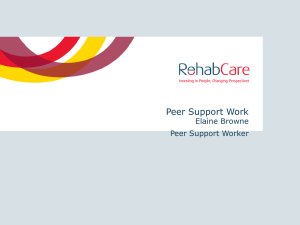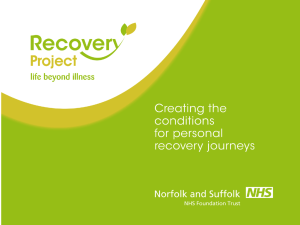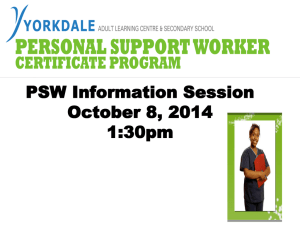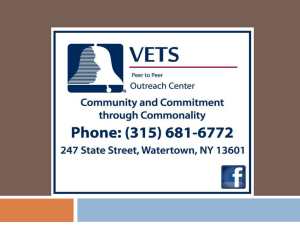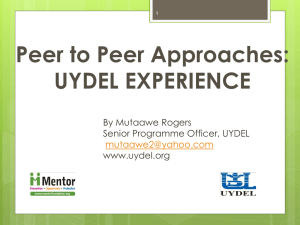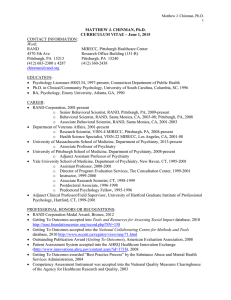Peer Support - Kent and Medway NHS Payroll Services
advertisement
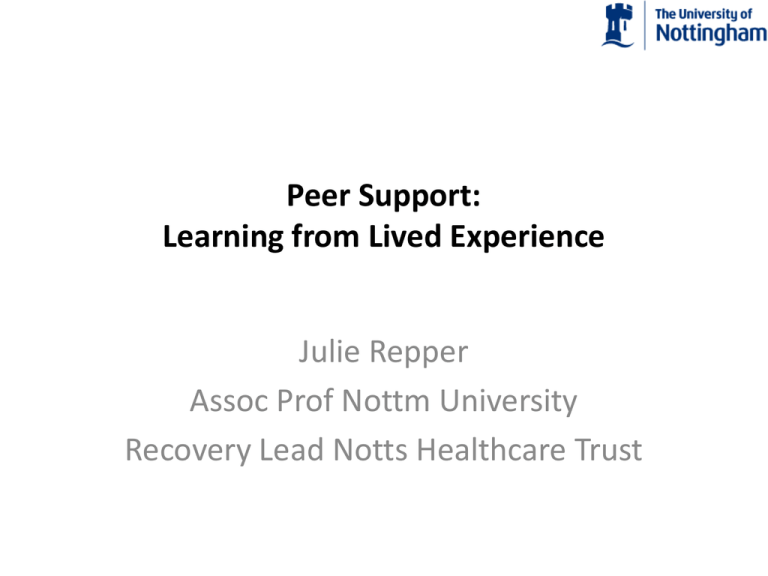
Peer Support: Learning from Lived Experience Julie Repper Assoc Prof Nottm University Recovery Lead Notts Healthcare Trust How can we develop peer support worker posts in the Trust in a way that is effective, supportive, successful? • Peer Support was an agreed goal in Recovery Strategy • Inspired by visit to Arizona • Won funding for peer support workers in the Trust • Recognised need to provide training for peer support workers • Started by learning from others’ experiences Three types of peer support • informal (naturally occurring) peer support, • peers participating in consumer or peer-run programs, • employment of consumers/service users as providers of services and supports within traditional services. Davidson et al (1999); Bradstreet (2006) The clear distinction between Peer Support Workers and other roles is the requirement of post holders to explicitly draw on and share their own experiences of emotional distress and/or of using mental health services in order to inspire, model, support and inform others in similar situations. What is peer support? • ‘ a system of giving and receiving help founded on key principles of respect, shared responsibility, and mutual agreement of what is helpful’. Mead (2003, p1) • Assumes that people who have similar experiences can better relate and can consequently offer more authentic empathy and validation, also that peers use their own experience of overcoming mental distress to support others who are currently in crisis or struggling (Mead & Macneil, 2004) • Focuses on strengths and recovery: the positive aspects of people and their ability to function effectively and supportively, (Carter 2000). • In both mutual support groups the relationships that peers have with each other are valued for their reciprocity; where peers are employed to provide support the peer employed in the support role is generally considered to be further along their road to recovery (Davidson et al, 2006). • “Peer support is about being an expert at not being an expert and that takes a lot of expertise” (Recovery Innovations Arizona, 2009) Role of PSWs • offering understanding, acceptance, empathy; role modeling and provision of practical information, support to access community facilities, ideas about coping strategies and problem solving skills; exposure to “alternative worldviews, ideologies and contexts” Davidson et al 2006 p.448. • “peer support relationships can challenge unacknowledged stigma, discrimination, bias and emphasize full community inclusion over a singular focus on symptom management whilst instilling hope for recovery by role modeling that recovery is possible, helping service users navigate systems and teaching successful coping strategies” (Mowbray et al, 1997. P.398) IMPACT of PSW: Changes in Service Use • RCTs comparing teams with PSW and those without : no difference (Solomon & Draine, 1995; O’Donnell et al, 1999); longer community tenure (Clarke et al, 2000). • Comparison of outpatients receiving PS or not: reduction in rehospitalisations (Chinman et al, 2001 [50%], Forchuk et al, 2005; Min et al, 2007; Lawn et al, 2008 [300 bed days saved in first 3 months of PSW). • Comparison of individuals’ service use before and after PSW: reduction in hospitalisations of around 50% (Ashcroft and Johnson, 2009) • IMPACT of PSW: Inclusion, Empowerment, Social functioning • Empowerment [belief in, and ability to, overcome difficulties]: Improvements for providers and recipients of PSW (Ochaka et al, 2006; Davidson et al, 1999; Salzer, 2002; Resnick & Rosenheck, 2008) – ?Due to different experience of relationships. • Social Support: Improvements in quantity and quality of relationships (Nelson et al, 2007; Ochaka et al, 2006; Forchuk et al, 2005; Trainor et al, 1997) -? Due to more positive identity, positive role models, rehearsal of social skills. • Empathy & Acceptance: recipients of PSW feel more understood, accepted and liked than recipients of TAU. • Hope: qualitative studies frequently describe the hope inspired by meeting people who have similar experiences and people who have overcome similar challenges (Ratzlaff et al, 2006; Davidson et al, 2006) IMPACT of PSW: Benefits for PSWs • Increased self-esteem, confidence, empowerment (Salzer & Shear, 2002; Ratzlaff et al, 2006) - ?Due to helper-therapy principles (Reissman, 1965). • More beneficial for provider than recipient in terms of empowerment (Bracke et al, 2008) - ?Due to identity shift from patient o provider (Hutchinson et al, 2006). • Benefits of being employed (financial, social, status, structure) combined with the supervision and safety of a job in which they are free to disclose their difficulties (Mowbray et al (1998). • Progress personal recovery: Skills learnt on the job aid their own recovery (Salzer & Shear, 2002). IMPACT of PSW: Benefits for the System • Communication: help providers and patients to understand each other better (Chinman, 2006). • Reduce staff workload: complement work of other members of the team (Mowbray et al, 1996). • Change staff attitudes towards people with mental health problems & drive through the philosophy of Recovery (Johnson & Ashcroft, 2009). • Break down barriers between us and them: changing HR policies; keeping well at work plans for everyone. Implementing Peer Support 27 organisations employing PSWs: (Gates et al, 2007); summit of 23 States (Pillars of Support, 2010) SRN evaluation (McLean et al 2009) all identified similar impediments to PSW and all make similar recommendations: • Training for PSWs and the staff they will be working with • Clear Job descriptions understood by PSWs and staff they are working with • Specific code of conduct for PSWs • Negotiate arrangement for future treatment of mental health problems on individual basis • Supervision and support within the mental health team and from peers. • At least two PSWs employed in each team • Develop a career structure with promotion opportunities Challenges • Friend or worker? Ongoing negotiation of relationships between PSWs and peers; some debate about levels of reciprocity; acknowledgement about ‘grey’ areas and the importance of supervision (Mowbray et al, 1998; Coleman, 2009; Macneil & Mead, 2003). • Power: do payment, training and titles preclude genuine peer support? How can social constructed disparities in status (Dr vs mental patient) be managed team relationships? Fisk et al, 2000; Davidson et al, 2009). Dixon et al (1997) found that staff who work with PSWs are more positive than staff who don’t. • Stress: stressors include working with people who are either very disturbed or ‘stuck’ (Mowbray et al, 1998); supervision, training and ‘keeping well at work’ plans are important to manage stress. (Paulson et al, 1999; McLean et al, 2009). Challenges • Accountability: PSWs worry about accountability for people’s decisions, particularly around risk (Chinman et al, 2006; Mead and MacNeil, 2004) describe development of shared responsibility and relational safety planning. • Distinctive role: PSWs in traditional mental health services may well be socialised into routine practice (Solomon, 2004) so specific measures need to be introduced to define, maintain and value their distinctive role (e.g. Peer supervision, Recovery Strategy, Recovery language). Training Core topics covered in available training courses include: • • • • • • • Recovery and personal recovery planning Peer Support (what it is and how it is distinct) Code of conduct (ethical issues, peer relationships and boundaries) Active listening skills Recovery language Problem Solving Understanding Difference e.g. Coleman (2006), RIAZ (2009), Repper, Arnold etc (2010)Must Making the Training Work • Careful selection – are they ready? • Support and opportunities for unsuccessful applicants • Two day preparation – Personal Recovery Planning • Practice placement throughout training • Self - assessment of practical competence throughout training • Option to undertake accredditted written assessment Ongoing Supervision, Training and Supervision “the necessity of consistent mentoring and supervision for peer support workers cannot be over-emphasised” (Mowbray et al, 1996) • Managerial supervision – to deal with requirements of job, policy, procedures, team relations, time management and productivity. • Peer supervision – to provide support, problem solving, trouble shooting, help to negotiate the ambiguities and complexities of the role. Conclusions • PSWs have the potential to improve the experience of people receiving support, to reduce their service use and increase social inclusion, social support and empowerment. • Can drive Recovery focussed practice through challenging language, practices and relationships • Cannot do this alone, need consistent and effective support, supervision and management • Not yet clear whether a critical mass of PSWs is required to promote significant change (how many? see RIAZ & Cambridge) • Very little mention of family/carer peer support workers. • Challenges from self help organisations about distortion of the concept of peer support work in statutory organisations • How can we maintain the best of peer suport whilst making it work in statutory services? • Important to work in partnership and learn together. Progress in Nottingham • Developed accredited training • Piloted 6fte peers for one year, evaluated and set up a dedicated peer service targeting: discharge and outpatients. • Won further funding to develop peers further • Now an established part of the Recovery ‘movement’ within the Trust 18 fte PSWs and 2 carer-PSWs. • Continue to learn … • “Inspire to influence” Julie.repper@nottingham.ac.uk
